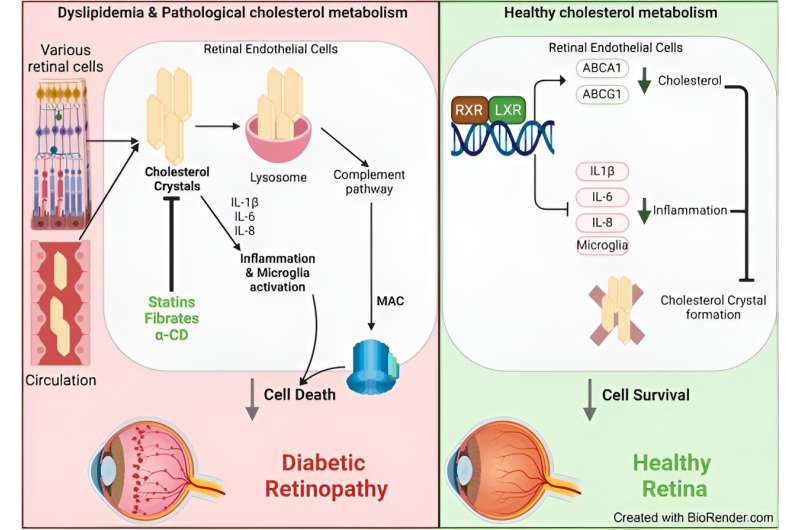This article has been reviewed according to Science X's editorial process and policies. Editors have highlighted the following attributes while ensuring the content's credibility:
fact-checked
peer-reviewed publication
trusted source
proofread
Researchers discover link between cholesterol and diabetic retinopathy

Advancements that could lead to earlier diagnosis and treatment for diabetic retinopathy, a common complication that affects the eyes, have been identified by a multi-department research team from Michigan State and other universities.
Their findings were recently published in the journal Diabetologia. Additional contributors are from the University of Alabama at Birmingham, Case Western Reserve University and Western University of Health Sciences.
Researchers found that diabetes, age-related health conditions and other metabolic disorders can lead to a buildup of cholesterol in the retina. This tends to crystalize and contribute to the development of diabetic retinopathy.
Crystalized deposits are very reflective and can be seen in images of the retina. This is important because noninvasive retina evaluations can be done by most optometrists, creating an opportunity for earlier diagnosis for more people.
"Retinopathy is the leading cause of preventable blindness and one of the most feared complications of type 1 and type 2 diabetes," explained Julia Busik, MSU professor emeritus of physiology. "Within 20 years of developing diabetes, every individual with either type 1 or type 2 diabetes will have some degree of retinopathy. Current treatment approaches are very invasive and are only directed at the very late stage of retinopathy."
"We are actively pursuing what can be done to lower cholesterol in the retina," said Tim Dorweiler, a doctoral candidate in the Molecular, Cellular and Integrated Physiology Program at MSU and first author of the paper. "The retina is a very isolated organ, just like the brain, and both have a blood barrier that separates them from the rest of the body. This is what makes the retina hard to study and extremely complex."
George Abela, chief of the MSU Division of Cardiology, said that these cholesterol crystals are like the crystals found in atherosclerotic plaque that can form in arteries and cause heart attacks, a finding discovered in his lab at MSU. He helped the research team identify ways to scan retinas using modified tissue preparation for scanning electron microscopy. This also helps researchers analyze the composition of the crystals, which typically result when there is too much cholesterol in one place.
There is also hope that new treatments to address crystals formed by cholesterol could be less invasive than current options for diabetic retinopathy. And there are questions about other areas of the body where these crystals could be treated to prevent other diseases.
More information: Sandra S. Hammer et al, Cholesterol crystal formation is a unifying pathogenic mechanism in the development of diabetic retinopathy, Diabetologia (2023). DOI: 10.1007/s00125-023-05949-w





















